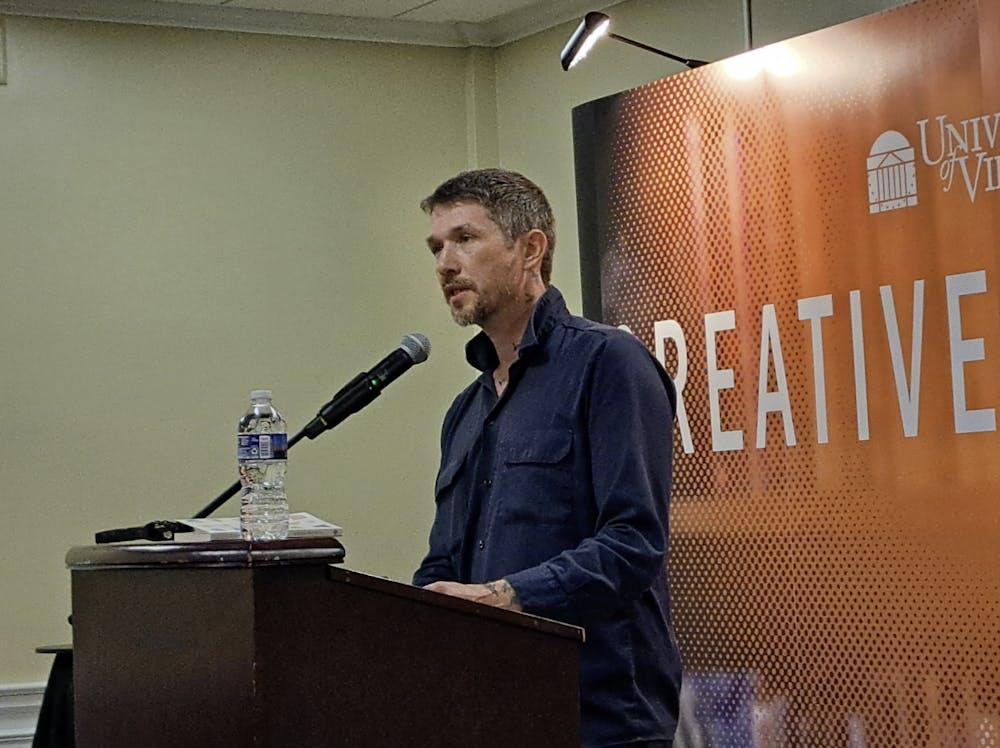Nestled in one of Newcomb’s upper alcoves, unforgettable impressions of one-eyed dogs, underwater cables and white apples were spoken into being. A crowd of students, writers and instructors gathered for what was innocuously advertised as a fiction reading, but which soon became a colorful, confounding evening Monday, full of vivid prose, enigmatic poetry and paradox.
In a self-titled “journey through books,” writer Jesse Ball treated listeners to some of his most beloved original and non-original pieces in an event hosted by the University’s Creative Writing Program. Ball — renowned author of over 16 published works and creator of cryptic drawings — is teaching two classes on creative writing at the University this semester as part of the Kapnick Foundation Distinguished Writer-in-Residence Program, offering up his expertise to aspiring writers.
Modeled on novelist William Faulkner’s residencies at the University in the 1950s, the Kapnick Foundation’s Writer-in-Residence Program has brought internationally lauded writers to Grounds for the past nine years. Their extended stays grant students and the broader Charlottesville community a chance to cherish and learn from contemporary literary masters.
Many of Ball’s students attended the event as well, such as fourth-year College student Julia Hyde. Hyde is in “Novellas, Very Short Novels, Very Long Stories,” in which students read, present on and discuss different novellas each week.
“We basically learn by example, because we are a big messy collection of everything we've ever read, and that's how we write things,” Hyde said. “His talk really demonstrated that we take inspiration from everywhere, and like he said, we're never ever truly original, but I think that's where innovation really shines.”
Ball’s reading selections ranged from works by the avant-garde poet Daniil Kharms to Japanese haiku master Matsuo Bashō. The night began with a reading from “Fratar sa zelenom bradom” by Vladan Desnica, which detailed the story of a man obsessed with a dream of a green-bearded friar before evolving into a curious tale of a one-eyed dog.
The short story, which meditated on the fickle, fleeting nature of memory, invited readers to imagine a dog missing its right eye. The narrator then described how certain sights — such as a one-eyed cat — might call the image of the one-eyed dog to mind.
“‘The conclusion might be drawn that every object can remind us of every other object,’” Ball said, quoting Desnica. “‘Those things which remind us of something else need not depend on some similarity or dissimilarity, but on something quite different — on what I don't know, but I'm sure it's something which … lies deep under the water, like a cable.’”
In drawing unconventional comparisons, Desnica’s story laid the groundwork for the rest of the night, in which Ball similarly wove together many disparate works and unorthodox images. One such example Ball cited was Donald Hall’s poem “White Apples,” wherein “white apples and the taste of stone” were likened to the feeling of losing a father.
Brief phrases and mental objects, like that of the white apple, were subjects of critical inquiry for Ball. He posited that writers and readers interact with those “irreducible” phrases in a host of ways, whether temporally, phenomenologically or verbally.
Regardless of the material in question, Ball’s characteristic sense of humor peeked through. He deftly juxtaposed wry anecdotes with philosophical musings, eliciting both lighthearted laughs and contemplative silence in turn.
“A sense of humor is a perception of multiple parallel dynamics that exist in the room and sets up a certain kind of tension,” Ball said. “To use your sense of humor is simply to publicly claim that there are two things going on, and it allows everyone to get that tension out.”
The same oscillation between jocular tone and gravitas is evident in Ball’s most recent book, “Autoportrait.” The memoir exemplifies his rapid, prolific writing style — all 140 pages were completed during the course of a single day. Ball’s numerous works are predominantly composed within a few weeks, at most.
The University currently features “Autoportrait” at the University Bookstore and continues to host writers like Ball through the Creative Writing Program. Though Ball’s absurd, imaginative reading was one-of-a-kind, every speaker has something unique to offer.







